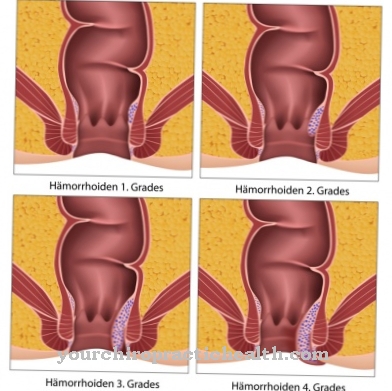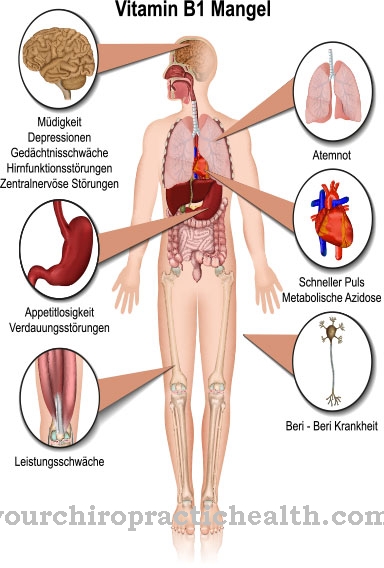The term carcinoma is a medical term: more precisely, it comes from pathology and describes a certain type of malignant tumor. In this respect, it is also advantageous for affected patients to understand the word and to have an overview of the associated problems and therapeutic approaches. Of course, every tumor is different; lung cancer has a completely different therapy and prognosis than testicular cancer. However, since both are carcinomas, there are fundamental similarities. Therefore, the following is a general overview.
What is a carcinoma?

A carcinoma is a malignant tumor (cancerous growth) that originates from the covering tissue (epithelium) of the skin or mucous membranes.
Since most cancers originate from such epithelia, around 80 percent of them are classified as carcinomas, including bronchial carcinoma (lung cancer), breast carcinoma (breast cancer) and colon carcinoma (colon cancer) as three of the most common types of cancer.
Depending on the type of epithelium on which it is based, a further classification into squamous cell carcinoma (from squamous epithelium), adenocarcinoma (from glandular tissue) and other less common categories can be made.
causes
Causes of Carcinoma are confusing, have not yet been fully researched and, moreover, cannot be generalized for all types of cancer.
Basically, many cells and tissues in the body constantly divide. The surfaces (epithelia) in particular are exposed to heavy loads both outside (skin) and inside (intestines, lungs) and must therefore be renewed regularly. By their very nature, epithelia are particularly actively dividing tissue - this is why cancer is so common there.
In cell division and DNA duplication, errors regularly occur in which control over cell division is lost and an individual cell is put in the state of wanting to continue dividing in an uncontrolled manner. Such small cancer cells arise in each of us many times a day - cancer development is therefore also a matter of chance. A healthy immune system is not only able to defend itself against viruses and bacteria, but also to destroy cancer cells that have developed immediately. Immunodeficiency can therefore favor the undetection and thus the further growth of a Tunmor cell.
Another major risk factor is tissue damage caused by external influences. The classic example is damage to the epithelium of the bronchial tubes by nicotine and other components of cigarette smoke - this weakens the defenses of the bronchial mucosa and directly damages the DNA of individual mucous membrane cells. The epithelium changes through constant exposure to smoke in order to become more resistant (metaplasia) - but in the process it also loses its original structure and the body loses control over epithelial growth; bronchial carcinoma can develop.
In the case of colon cancer, a lack of dietary fiber (i.e. culturally induced malnutrition) has been identified as a major risk factor, as this leads to chronic constipation and other food-borne toxins can act on the intestinal mucosa for longer. Genetic factors are also important here - as is the case with many other cancers.
Carcinomas of the upper gastrointestinal tract (e.g. gastric carcinoma) or the lower urinary tract (such as kidney carcinoma or bladder carcinoma) are meanwhile often associated with nitrosamines, cervical cancer with papilloma viruses, white skin cancer with chronic UV light Burden. There are many different risk factors for the many different carcinomas that have a more or less direct and major influence on tumor development.
Symptoms, ailments & signs
The symptoms of such Carcinoma and thus the time of its discovery depends very much on the location of the tumor. Skin cancer tends to be seen and treated early, while lung tumors can grow unmolested for years and may have metastasized throughout the body by the time it is diagnosed.
Bleeding is a frequent first symptom of internal tumors (blood in the stool, blood in the urine, bloody cough) and must therefore be clarified. Functional restrictions can affect the hollow organs and lead to constipation (colon carcinoma), cough (bronchial carcinoma) or biliary colic and jaundice (bile duct carcinoma). Other tumors such as gastric carcinoma are not discovered for a long time because the hollow organ is simply large enough to bypass the tumor.
Bone metastases, in particular, can also cause severe pain and thus lead to the discovery of the first tumor in the first place (e.g. in the case of spinal metastases from prostate cancer). Similarly, brain metastases can become noticeable through changes in character or failure of sensory organs and can be the first symptom of a malignant carcinoma in a completely different place.
Otherwise there is the term "B-symptoms" in medicine: This means all those unspecific symptoms that do not indicate a specific tumor, but generally accompany a malignant cancer and should therefore be taken into account: These include weight loss, loss of appetite , Weakness, tiredness, high temperatures, night sweats and similar complaints. These symptoms arise because the rapidly growing tumor devours an enormous amount of energy to grow, which the rest of the body then lacks. Anemia as a result of creeping blood loss (tumor bleeding) and the accompanying inflammatory processes can also contribute to the symptoms.
Diagnosis & course of disease
The diagnosis includes a thorough anamnesis with targeted questioning of complaints, risk factors and accompanying phenomena. A family history is also important, as some tumors are inherited more frequently. The physical examination can sometimes confirm the suspicion of a tumor, for example if a colon cancer can already be felt with a finger in the bottom.
Imaging examinations such as ultrasound, X-ray, CT and MRT are then carried out, which serve both to precisely depict the cancerous ulcer and to search for metastases. When planning therapy, it is important to obtain as comprehensive an overview as possible of the status of the disease, as a large number of different and well-researched therapy strategies are available on this basis and metastases, for example, can fundamentally change the treatment protocol. In oncology (cancer medicine) one speaks of so-called "staging", ie the division of the tumor into different categories according to its stage. A popular classification here is the TNM classification according to tumor size, nodal (lymph node) status and metastases.
An attempt is almost always made to get a tissue sample (biopsy). Only on the basis of this can the type of tissue of the tumor be proven beyond doubt and certainty in the selection of the correct therapeutic approach can be obtained. The pathologist speaks of "grading" (one can therefore prove the degree of tumor development).
Complications
In any case, carcinoma is a very dangerous health condition for the patient. It is not uncommon for it to lead to the death of the person affected either by itself or due to its consequences. For this reason, early detection and treatment is extremely important so that possible complications can be avoided.
The symptoms and complications of a carcinoma usually depend heavily on the affected region. Furthermore, the cancer usually spreads to other regions of the body and can also affect and damage healthy tissue. In the brain in particular, there are personality changes or paralysis and other motor failures.
Those affected suffer from severe weight loss and weakness. The resilience of the person concerned also decreases and there is permanent fatigue that cannot be compensated with the help of sleep. Treatment of the cancer is not always possible. In many cases, it will also reduce life expectancy. With chemotherapy, many severe side effects, such as hair loss, can occur and thus further reduce the quality of life of the person affected.
When should you go to the doctor?
In the case of unusual and incomprehensible swellings on the organism, the complaints should always be clarified by a doctor. If there is a feeling of tightness in the body, bulging or the development of ulcers, medical examinations are necessary. Since 80% of carcinomas are responsible for the development of a malignant tumor, a doctor should be consulted at the first discrepancy. If breathing is impaired, digestive problems, headaches or various functional disorders occur, a visit to a doctor is advisable.
If the symptoms persist or worsen over several weeks or months, the observations should be discussed with a doctor immediately. If existing complaints gradually spread, there is also an urgent need for action. To determine the cause, a visit to the doctor is necessary in the event of a vague feeling of illness, a general malaise, a decrease in the usual level of performance or an increased need for sleep.
Restlessness, unexplained fears, greater weight loss, apathy, and increased irritability indicate irregularities that should be reported to a doctor. The permanent feeling of powerlessness or lack of energy, changes in the mucous membranes or the complexion of the skin as well as a sensation of pain are indications of an existing disease. A doctor should be consulted if sensitivity disorders, mobility restrictions or psychological abnormalities develop. If there is a deviation from the usual behavior, a visit to the doctor is recommended.
Treatment & Therapy
The therapy includes exactly three different strategies: surgical removal, chemotherapy and radiation of the tumor. All three are very radical procedures that can cause a lot of collateral damage, but in the best case scenario remove the tumor and its last cancer cell from the body and thus defeat the disease once and for all.
Because of their superficial location, many carcinomas are initially easy to operate, especially when they are still quite small. Depending on the stage, this is often followed by chemotherapy or radiation in order to clean the surrounding tissue (lymph drainage pathways) and the entire body (metastases) of scattered tumor cells. However, these treatments must be used with caution as they are poison for the entire body and can have a lot of side effects.
On the other hand, according to the current state of research, they usually represent the only way to treat a cancerous ulcer comprehensively and safely. More targeted drugs are currently being developed and are only available in individual cases (e.g. for certain types of leukemia).
Outlook & forecast
Thanks to medical and scientific advances, the prognoses for carcinomas have improved significantly in recent years. Early detection measures and awareness-raising among the population enable many patients to diagnose and treat early in the disease. Doing this improves the prognosis and the prospect of permanent recovery.
However, there is no generally valid prognosis when it comes to carcinoma. It must always be checked individually at which point in the organism the tumor formed and at what speed the growth takes place. Some areas in the body are difficult to access and other regions only allow early detection in rare cases.
The further the tumor has grown in the organism, the older a patient is and the more previous illnesses they have, the less favorable the prognosis. The way of life, the general state of health and mental stability also have an influence on the further healing process. Without taking advantage of medical care, there is a risk of the patient's premature death. An aggressive or malignant tumor has no prospect of spontaneous healing. It can only be treated and removed in cancer therapy. It is a long-term therapy that is associated with various risks and has a risk of relapse.
prevention
Prevention is the best way to get through life cancer-free: Since the most common types of cancer are clearly associated with risky behavior, one could say that. In detail, this means: no smoking, little alcohol, avoiding nitrosamines, only enjoying sunlight in moderation, striving for a diet rich in fiber and everything else that is considered good and healthy.
There are specific preventive measures against individual cancer entities, such as the HPV vaccination against cervical cancer. In addition, early diagnosis examinations such as colonoscopy from 55 or mammography are highly recommended.
Aftercare
Follow-up care is a central element in the therapy of carcinomas. In this way, the recurrence of a disease should be determined as early as possible, from which doctors expect advantages in the context of therapy. After an operation, radiation or ablation there is always the risk of tumor recurrence.
In addition, aftercare is also about offering everyday support. Patients often complain of psychological problems after an operation and need help in everyday life. A carcinoma cannot always be completely removed. Then it is not uncommon for long-term treatment to be necessary. Daily drug treatment remains inevitable.
Patients usually have a follow-up visit once a quarter or every six months. Which rhythm is indicated depends on the type of cancer, the complaint situation and the tumor stage at the initial diagnosis. The breaks between appointments are usually lengthened if no new growth has been detected after two to three years.
The family doctor or a clinic is responsible for follow-up care. Essential elements of an appointment are an in-depth discussion and a physical check-up. An ultrasound examination and other imaging tests are arranged regularly. Blood tests to determine specific markers are also carried out.
You can do that yourself
Cancer treatment is in the hands of experienced doctors, but the patient can do a lot to help him or her recovery through a positive outlook on life.
Above all, this includes dealing with one's situation and accepting the illness: Open discussions with relatives, friends and other affected persons can be extremely helpful. The design of everyday life should be tailored to the current state of health and allow enough time for rest breaks - this also includes accepting outside help in poorer phases. Light sporting activities usually have a positive effect on the psyche and body, intensity and extent should be discussed with the attending physician.
Equally important is a healthy, balanced diet that protects against deficiency symptoms and counteracts weight loss due to illness as well as possible. Several small portions a day are usually better tolerated than a few large ones. Adequate hydration should also not be forgotten.
Specific relaxation exercises and acupressure can help reduce nausea caused by chemotherapy. Mistletoe preparations also have a reputation for reducing side effects, but their effectiveness is controversial. If the cancer causes severe pain, it makes sense to keep a pain diary. This should be presented to the doctor at each visit so that he can quickly adjust the drug therapy in the event of changes.




.jpg)



















.jpg)



